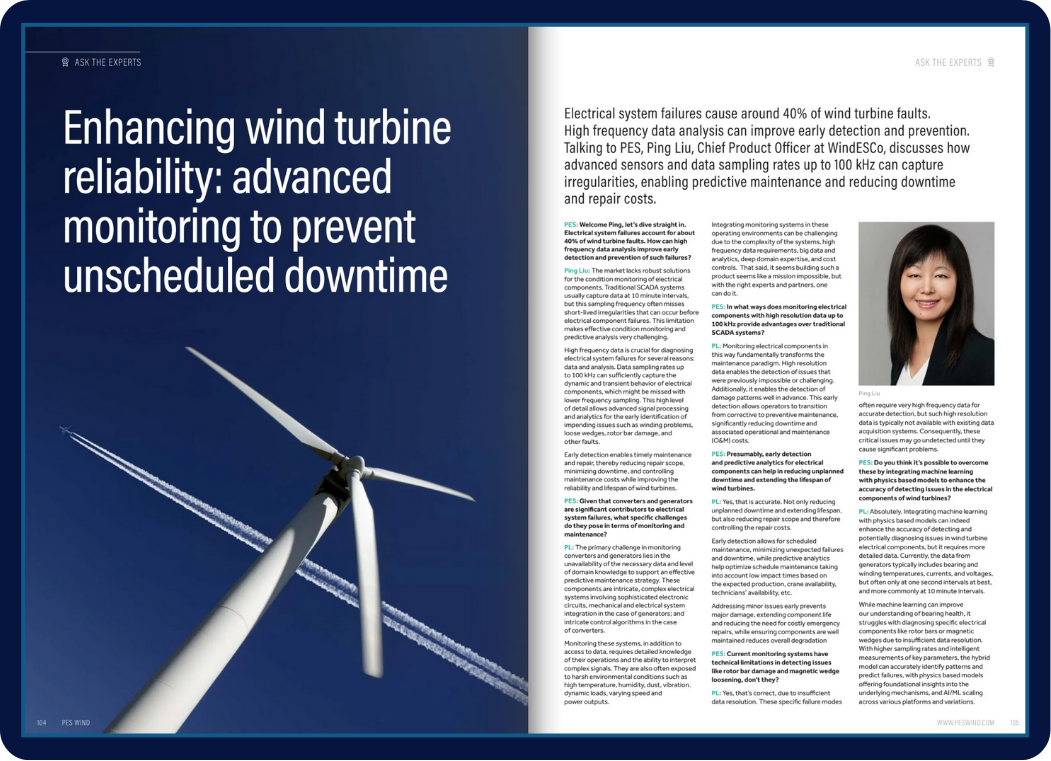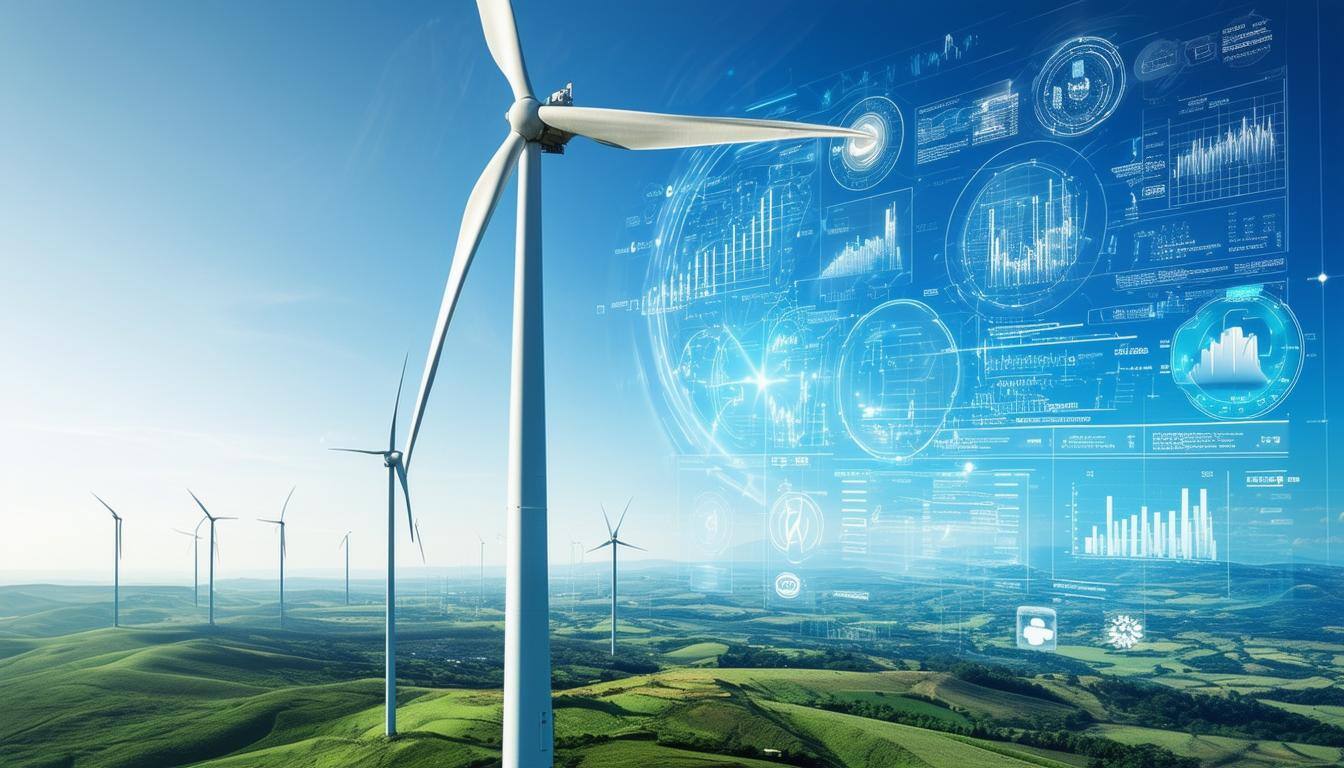AI Center Lightning Talk: AI-Driven Asset Health in Wind Energy
On September 25, 2024, WindESCo's Senior Technical Lead in EMEA, Zuri Zugasti, shared fascinating insights at the WindEnergy Hamburg conference,...
8 min read
WindESCo Sep 23, 2024 2:01:01 PM

In a recent "Ask the Experts" interview with PES Wind (Issue 3, 2024), our Chief Technology Officer, Ping Liu, discusses how advanced sensors and data sampling rates up to 100 kHz can capture irregularities, enabling predictive maintenance and reducing downtime and repair costs.
PES: Welcome Ping, let’s dive straight in. Electrical system failures account for about 40% of wind turbine faults. How can high frequency data analysis improve early detection and prevention of such failures?
Ping Liu: The market lacks robust solutions for the condition monitoring of electrical components. Traditional SCADA systems usually capture data at 10 minute intervals, but this sampling frequency often misses short-lived irregularities that can occur before electrical component failures. This limitation makes effective condition monitoring and predictive analysis very challenging.
High frequency data is crucial for diagnosing electrical system failures for several reasons: data and analysis. Data sampling rates up to 100 kHz can sufficiently capture the dynamic and transient behavior of electrical components, which might be missed with lower frequency sampling. This high level of detail allows advanced signal processing and analytics for the early identification of impending issues such as winding problems, loose wedges, rotor bar damage, and other faults.
Early detection enables timely maintenance and repair, thereby reducing repair scope, minimizing downtime, and controlling maintenance costs while improving the reliability and lifespan of wind turbines.
PES: Given that converters and generators are significant contributors to electrical system failures, what specific challenges do they pose in terms of monitoring and maintenance?
PL: The primary challenge in monitoring converters and generators lies in the unavailability of the necessary data and level of domain knowledge to support an effective predictive maintenance strategy. These components are intricate, complex electrical systems involving sophisticated electronic circuits, mechanical and electrical system integration in the case of generators; and intricate control algorithms in the case of converters.
Monitoring these systems, in addition to access to data, requires detailed knowledge of their operations and the ability to interpret complex signals. They are also often exposed to harsh environmental conditions such as high temperature, humidity, dust, vibration. dynamic loads, varying speed and power outputs.
Integrating monitoring systems in these operating environments can be challenging due to the complexity of the systems, high frequency data requirements, big data and analytics, deep domain expertise, and cost controls. That said, it seems building such a product seems like a mission impossible, but with the right experts and partners, one can do it.

PES: In what ways does monitoring electrical components with high resolution data up to 100 kHz provide advantages over traditional SCADA systems?
PL: Monitoring electrical components in this way fundamentally transforms the maintenance paradigm. High resolution data enables the detection of issues that were previously impossible or challenging. Additionally, it enables the detection of damage patterns well in advance. This early detection allows operators to transition
from corrective to preventive maintenance, significantly reducing downtime and associated operational and maintenance (O&M) costs.
PES: Presumably, early detection and predictive analytics for electrical components can help in reducing unplanned downtime and extending the lifespan of wind turbines.
PL: Yes, that is accurate. Not only reducing unplanned downtime and extending lifespan, but also reducing repair scope and therefore controlling the repair costs.
Early detection allows for scheduled maintenance, minimizing unexpected failures and downtime, while predictive analytics help optimize schedule maintenance taking into account low impact times based on the expected production, crane availability, technicians’ availability, etc.
Addressing minor issues early prevents major damage, extending component life and reducing the need for costly emergency repairs, while ensuring components are well maintained reduces overall degradation.
PES: Current monitoring systems have technical limitations in detecting issues like rotor bar damage and magnetic wedge loosening, don’t they?
PL: Yes, that’s correct, due to insufficient data resolution. These specific failure modes often require very high frequency data for accurate detection, but such high resolution data is typically not available with existing data
acquisition systems. Consequently, these critical issues may go undetected until they cause significant problems.
PES: Do you think it’s possible to overcome these by integrating machine learning with physics based models to enhance the accuracy of detecting issues in the electrical components of wind turbines?
PL: Absolutely. Integrating machine learning with physics based models can indeed enhance the accuracy of detecting and potentially diagnosing issues in wind turbine electrical components, but it requires more detailed data. Currently, the data from generators typically includes bearing and winding temperatures, currents, and voltages, but often only at one second intervals at best, and more commonly at 10 minute intervals.
While machine learning can improve our understanding of bearing health, it struggles with diagnosing specific electrical components like rotor bars or magnetic wedges due to insufficient data resolution. With higher sampling rates and intelligent measurements of key parameters, the hybrid model can accurately identify patterns and predict failures, with physics based models offering foundational insights into the underlying mechanisms, and AI/ML scaling across various platforms and variations.
Combining these methods can significantly improve the detection and prediction of complex failure modes, provided the data quality and resolution are sufficient.
PES: Is there a potential economic impact of addressing electrical component failures early as well and, if so, how can financial impact assessments guide decision making?
PL: Addressing electrical component failures early can have a significant economic impact by reducing repair scope and cost, reducing downtime, and increasing productivity. When critical components like generators or gearboxes fail, large cranes are needed to replace them. Since wind farms typically do not own these cranes, they must rent them, which is time consuming and expensive.
Another challenge is the availability of spare parts, which can sometimes take too long to obtain. For example, our partner ABB addresses this problem by maintaining an emergency stock, allowing for quicker delivery, and reducing dependency on the supply chain. By reducing downtime to approximately two weeks, we can significantly boost turbine availability. This translates into substantial revenue gains, which should motivate us to strive for more efficient maintenance practices.
Moreover, early intervention helps prevent minor issues from escalating into more serious and costly problems. For example, annual generator failure rates range from 1% to 5%. Minor maintenance tasks, such as bearing replacement or minor rewinding, typically cost around $30,000. In contrast, if issues escalate, costs can increase dramatically: moderate repairs or significant rewinding may cost four times as much, while a complete replacement or major rebuild can reach up to $350,000.
 PES: Describe some of the innovations you think are needed to improve the monitoring and maintenance of converters and generators, given their critical role in electrical system failures.
PES: Describe some of the innovations you think are needed to improve the monitoring and maintenance of converters and generators, given their critical role in electrical system failures.
PL: To improve the monitoring and maintenance of converters and generators, several innovations are needed. One of these is enhanced sensor technology; the installation of sensors that can capture high resolution data with greater accuracy and sensitivity. These sensors should be capable of monitoring electrical, mechanical, and thermal conditions at higher frequencies to detect anomalies in the electrical subcomponents.
Higher data sampling rates are also needed. The implementation of systems that support high frequency data sampling, e.g., 100kHz, will capture sufficient dynamic and/or transient behavior for advanced signal processing and analytics to detect early signs of failure.
Integrated failure detection analytics is also important: Advanced machine learning algorithms combined with physics based models to analyze complex interactions within converters and generators. These models should provide near real time detection of relevant failure modes and predictive insights.
Finally, real time data analytics is necessary. Development of robust big data and analytics platforms on the edge that can process and interpret large volumes of high frequency data in real time, allowing for immediate detection of issues and timely maintenance actions. WindESCo, in collaboration with ABB, has already developed a solution that accounts for all these innovations and that can effectively monitor the condition of the converters and generators.
PES: How can the industry leverage high frequency data to optimize the performance of both mechanical and electrical subsystems in wind turbines?
PL: We were talking about static yaw misalignment, which is actually a great example of how the high frequency data, one to 30 seconds in this case, can be leveraged to optimize the performance of a mechanical subsystem. Our recent case study compares the performance of a high frequency based algorithm with a traditional 10 minute interval algorithm and results from two lidar campaigns. The high frequency algorithm shows a strong correlation with lidar measurements, whereas the 10 minute algorithm reveals substantial discrepancies. Similarly, for dynamic systems like pitch control, high frequency data is crucial for precise analysis and optimization.
For the electrical subsystems performance optimization, a higher frequency of data allowed a more detailed representation of the systems, for example, converters operate at high switching frequencies, which means
condition monitoring naturally needs to be at a higher frequency as well. It’s important to recognize that we select the right frequency of data to solve the right problems. For some problems, 10 minute data is enough, we just need to be cognizant of what we are solving for.
PES: How does WindESCo’s approach to monitoring yaw misalignment contribute to overall turbine efficiency, and what are the limitations of traditional methods?
PL: Our approach enhances overall turbine efficiency by leveraging data based solutions rather than traditional methods.
So, what are the traditional methods? They typically include LiDAR, spinner anemometers, and met towers. LiDAR, which uses laser beams to measure wind speed and yaw alignment, provides continuous monitoring but is costly and needs to be moved between turbines.
Traditional nacelle mounted anemometers, and spinner anemometers mounted in front of the blades, offer real time detection but also come with high costs and calibration challenges; Met towers can measure wind direction with accuracy within ±5°, but are limited to flat topography and turbines within 2 to 5 rotor diameters of the tower. These methods also require significant investment and logistical effort.
WindESCo’s approach, in contrast, uses the turbine’s SCADA data to estimate and correct yaw misalignment. By modeling the relationship between wind characteristics and turbine behavior with high frequency data, our algorithm integrates machine learning with physics based methods to continuously estimate static yaw misalignment.
This approach adapts to changing conditions over time and has demonstrated 1 to 2% improvements in annual energy production (AEP) across various turbine models and locations. This translates to potential annual revenue increases of $2,000 to $4,000 per turbine, or $200,000 to $400,000 per wind farm, depending on its size and power purchase agreements (PPAs).
PES: Collaboration between technology providers and operators plays a key part in overcoming the challenges of monitoring and maintaining complex turbine subsystems, doesn’t it?
PL: Yes, collaboration is essential for overcoming the challenges of monitoring and maintaining complex turbine subsystems. Technology providers bring crucial expertise and advanced solutions for system integration and maintenance. Working closely with operators ensures that these tools and insights, particularly concerning the health of electrical components, are effectively utilized and tailored to their specific operational needs, and adopted in their day to day workflow to help them do their job more effectively and efficiently, ultimately leading to improved profitability for the operators.
PES: Do you have any case studies you can share with us to illustrate the difference WindESCo is making?
PL: Yes, to demonstrate main bearing efficiency WindESCo has transformed predictive maintenance in wind energy with its semi supervised machine learning model. Utilizing existing SCADA data, recently Pulse delivered over 90% accuracy in detecting main bearing issues, demonstrating a benefit of $492,000 on 700 MW of capacity.
In the case of optimizing turbine performance, we were engaged by UPC Renewables, to enhance the performance of 79 MW of turbines by boosting their AEP by 2% without new hardware while adhering to the OEM full service agreement resulting in an annual revenue increase of $5,700 per MW. WindESCo optimized a 145 MW wind farm owned by Longroad Energy, increasing annual revenue by $430,000 through targeted adjustments. This case study covers strategies for enhancing plant output, correcting yaw misalignment and pitch settings, and leveraging AI based algorithms to improve performance.
Finally, WindESCo validated its SCADA based yaw misalignment detection against nacelle LiDAR data, demonstrating comparable accuracy with a higher ROI.
 PES: In what ways can modular and scalable solutions address the diverse needs of different sizes and types of wind plants, particularly concerning electrical component analytics?
PES: In what ways can modular and scalable solutions address the diverse needs of different sizes and types of wind plants, particularly concerning electrical component analytics?
PL: Modular and scalable solutions offer flexibility, cost efficiency, and tailored analytics that can address the diverse needs of different wind plants. For example, some customers have more concerns about the generators while others may have high priorities on converters. By giving customers, the option to select the ‘best fit’ modules
that meet their needs, would ensure that we are providing the maximum value to the customers.
PES: Looking to the future then, how do you think the insights gained from monitoring electrical components be used to develop more effective maintenance schedules and reduce operational costs?
PL: In the future, insights from monitoring electrical components will enable more effective maintenance schedules and lower operational costs by facilitating predictive maintenance, which identifies potential failures before they occur and allows for timely, planned interventions. Additionally, data from electrical components will also provide critical insights into mechanical components, and subsequently improve detection and diagnosis of various failure modes that may not be possible before, or do it more efficiently.
Overall, by using high resolution data, operators can transition from reactive to condition based maintenance, optimizing repair schedules around periods of low production and reducing unnecessary interventions. This approach helps prevent costly emergency repairs and extends component lifespan, thereby minimizing downtime and operational costs while enhancing overall turbine reliability and efficiency.
Reach out to the WindESCo team to learn more! Email us at contact@windesco.com

On September 25, 2024, WindESCo's Senior Technical Lead in EMEA, Zuri Zugasti, shared fascinating insights at the WindEnergy Hamburg conference,...
.png)
WindESCo has pioneered the detection of yaw misalignment from high-frequency (HF) SCADA data. However, in many cases implementing yaw misalignment...

Wind turbines are complex systems where failures in electrical components - such as generators, power converters, power electronics, drives and...